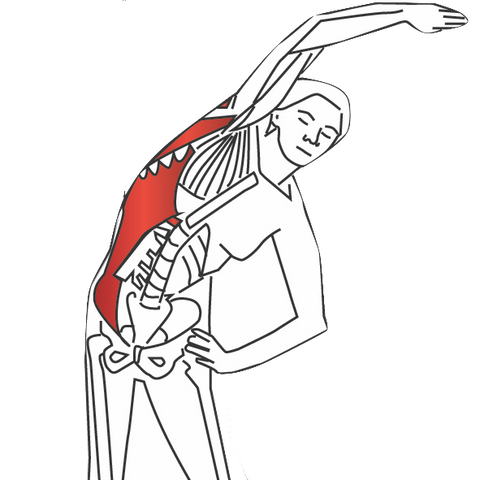Treating the Quadratus Lumborum

Quadratus Lumborum Muscle
Treating the Quadratus Lumborum
Active Trigger Points in the QL are Often Associated with Back Pain
The QL works together with the psoas for creating an anterior pelvic tilt. It also helps to stabilize the lumbar spine together with the transverse abdominis, and to function with the other “core” muscles.
When both sides of the QL contract together, this causes the lumbar spine to go into extension. When only one side contracts, it will either pull the rib cage downward to assist in lateral flexion (side bending) or it will raise one side of the pelvis upward.
Also noteworthy about the QL is that it is also used in respiration where it helps to stabilize the lowest rib.
Active trigger points in the QL are often associated with back pain, often as part of a wider "holding pattern" issue.
Quadratus Lumborum - Common Trigger Point Sites
Here (below) are 3 simple stretches that most people should be able to perform easily and safely:

Technique:
• Kneel on all fours• Lift one hand and reach towards your ankle
• Keep your back parallel to the ground
Primary muscles being stretched
Quadratus lumborum. External and internal obliques.
Secondary muscles being stretched
Injury where stretch may be useful
Lower back muscle strain. Lower back ligament sprain. Abdominal muscle strain (obliques).
Note: Keep your back straight, parallel to the ground, and your thighs in a vertical position. Distribute your weight evenly on both your hands and knees.

Primary muscles:
Secondary muscles:
Injury where stretch may be useful:
Note: Do not lean forward or backward. It's important to concentrate on keeping your upper body straight.

Technique:
Stand with your feet shoulder-width apart, then slowly bend to the side and reach over the top of your head with your hand. Do not bend forward.
Primary muscles:
Quadratus lumborum. External and internal obliques. Latissimus dorsi.
Secondary muscles:
Teres minor. Iliocostalis lumborum. Intertransversarii. Rotatores. Multifidus.
Lower back muscle strain. Lower back ligament sprain. Abdominal muscle strain (obliques).
Note: Do not lean forward or backward; concentrate on keeping your upper body straight.
Download Free Stretching Guide
NAT Education Membership Plans
Unlimited Access to all Courses

Links
Find a Trigger Point Professional in your area
More About Back Pain and Trigger Points
Dry Needling for Trigger Points
Certify as a Trigger Point Therapist
NAT Education Membership Plans from $19.95/monthly
This trigger point therapy blog is intended to be used for information purposes only and is not intended to be used for medical diagnosis or treatment or to substitute for a medical diagnosis and/or treatment rendered or prescribed by a physician or competent healthcare professional. This information is designed as educational material, but should not be taken as a recommendation for treatment of any particular person or patient. Always consult your physician if you think you need treatment or if you feel unwell.
About Niel Asher Education
Niel Asher Education (NAT Global Campus) is a globally recognised provider of high-quality professional learning for hands-on health and movement practitioners. Through an extensive catalogue of expert-led online courses, NAT delivers continuing education for massage therapists, supporting both newly qualified and highly experienced professionals with practical, clinically relevant training designed for real-world practice.
Beyond massage therapy, Niel Asher Education offers comprehensive continuing education for physical therapists, continuing education for athletic trainers, continuing education for chiropractors, and continuing education for rehabilitation professionals working across a wide range of clinical, sports, and wellness environments. Courses span manual therapy, movement, rehabilitation, pain management, integrative therapies, and practitioner self-care, with content presented by respected educators and clinicians from around the world.
Known for its high production values and practitioner-focused approach, Niel Asher Education emphasises clarity, practical application, and professional integrity. Its online learning model allows practitioners to study at their own pace while earning recognised certificates and maintaining ongoing professional development requirements, making continuing education accessible regardless of location or schedule.
Through partnerships with leading educational platforms and organisations worldwide, Niel Asher Education continues to expand access to trusted, high-quality continuing education for massage therapists, continuing education for physical therapists, continuing education for athletic trainers, continuing education for chiropractors, and continuing education for rehabilitation professionals, supporting lifelong learning and professional excellence across the global therapy community.

Continuing Professional Education
Looking for Massage Therapy CEUs, PT and ATC continuing education, chiropractic CE, or advanced manual therapy training? Explore our evidence-based online courses designed for hands-on professionals.


















